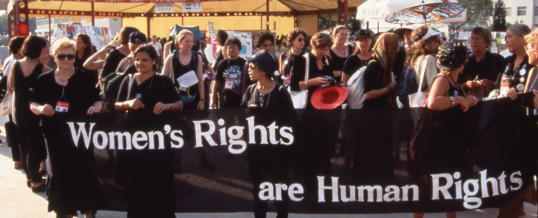
McLeod Group blog by Kirsten Van Houten and Diana Rivington, April 10, 2025
The Trump administration has banned a growing list of terms in relation to research, policy and programming, including gender, gender equality, women, LGBTQ rights, disability and race. These changes are emboldening other states to undermine global commitments to gender equality, including at the UN.
Over the years, Canada has become a leader globally in the promotion of women’s rights and gender equality. However, in the early days of the current federal election campaign, this commitment seems fragile, if not absent. Canadians who see value in continuing this agenda must raise gender equality as a priority with candidates and vote accordingly.
What’s in a Term?
The urgent need for global leadership to defend women’s rights and gender equality was highlighted during recent interviews with UN staff as part of a SSHRC-funded research project led by Kirsten on the contributions of women with disabilities to peacebuilding. Several participants reported that they had been told by US government representatives that they could not use the word gender in their documents or have it as a focus in their programming.
One staff person had considered removing the word “gender” from the title of their unit’s annual panel at the UN Commission on the Status of Women, although they ultimately decided against doing so. Participants worried that these requests were having a chilling impact, encouraging other states to work more actively against women’s rights and gender equality. Participants also reported ongoing struggles to achieve adequate representation of women in peace operations, peace negotiations and peacebuilding more broadly.
The participants’ comments align closely with other changes in foreign policy objectives announced by President Trump. The US government also withdrew from the World Health Organization and is in the process of dismantling its aid agency, USAID. The latter has already ended its support for sexual and reproductive healthcare and the protection of reproductive rights for millions of women living in the Global South. It also ended access to antiretroviral treatments which prevent mother-to-child HIV transmission, along with denying life-saving care to HIV/AIDS patients worldwide.
Gender Equality in Canadian Foreign Policy
Gender equality has long been a contested term. In the 1970s, the concept of gender began to emerge in academe and among feminist thinkers because of the need to differentiate between responsibilities and activities that are unchangeable because they are sex-related and gender-based ones that are socio-culturally determined, that is, learned through socialization and therefore changeable. Many of these ideas were incorporated into public policy at domestic and international levels. However, a strong “anti-gender ideology” lobby has emerged that threatens the gains made during this period.
It is vital that global progress made on gender equality not go back to these old debates. It is particularly important to remain steadfast in maintaining the respect for the rights of racialized and disabled women and trans people who face threats based on more than one aspect of their identity.
Since the adoption of the Beijing Platform for Action in 1995, Canada has maintained a fairly robust international gender equality policy. By 1999, most bilateral and multilateral development agencies, including CIDA, had updated their policy statements in line with the Beijing Platform. In the early 2000s, gender equality emerged as an area of focus in both development programming and Canada’s human security approach.
The Harper government pressured the Department of Foreign Affairs and International Trade, now GAC, to drop the term “gender equality” and replace it with “equality between women and men”. The Maternal, Newborn and Child Health strategy served to further limit the implementation of gender equality, and addressed neither contraception nor abortion. There were also cuts in other areas of equality work both nationally and internationally.
Prime Minister Justin Trudeau renewed Canada’s commitment to gender equality through its Feminist International Assistance Policy and the Elsie Initiative for Women in Peace Operations which have gained global attention. However, his successor Mark Carney’s commitment to gender equality came into question when he failed to appoint a Cabinet minister with a title related to women’s rights and gender equality. The continuing existence of such a ministry since 1971 has been a reflection of fundamental Canadian values. Canada’s international policy on gender equality is often aligned with its domestic efforts.
A Call to Action
Canada must continue to lead on women’s rights and gender equality in a global context where the space to conduct such work is shrinking. It can do so by strengthening the FIAP, the Elsie Initiative and fulfilling its National Action Plan on Women, Peace and Security, inclusive trade policies, and continuing to promote feminist foreign policy. Integral to meeting these commitments is new financial, program and policy pledges to supporting women human rights defenders and peacebuilders locally and globally. It must also continue to advance women’s rights domestically as part of this strategy, particularly where it intersects with race, disability and gender identity.
When Canadians are considering who to vote for in the upcoming federal election, they should ask local candidates about their commitments to these areas and then choose accordingly.
Kirsten Van Houten is Assistant Professor in the School of Social Justice and Global Stewardship at the University of the Fraser Valley. Data collection for her project “Finding Their Place: The Contributions of Women with Disabilities to Peacebuilding” is supported by Fabian Garcia. Diana Rivington, through her long career with the Canadian International Development Agency, made major contributions to CIDA’s Gender Equality policy and programming. Photo taken at the 1995 World Conference on Women in Beijing, courtesy of Diana Rivington.
